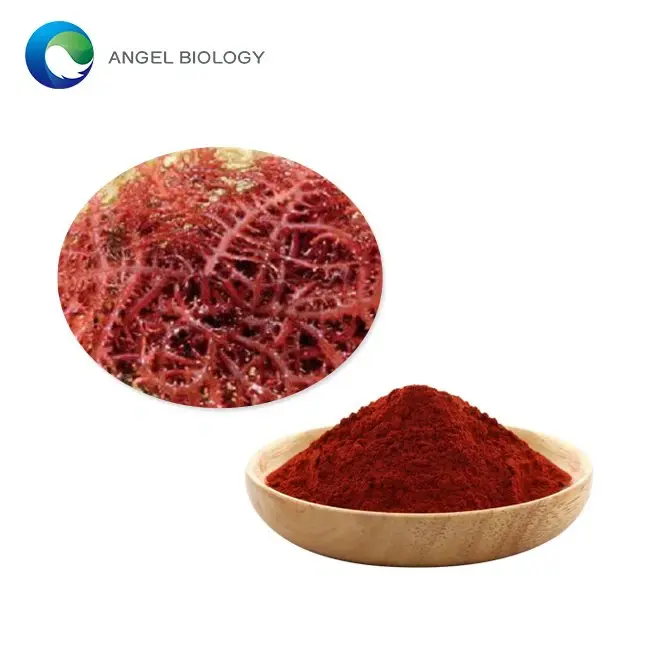Natural vs Synthetic Astaxanthin Powder: Key Differences?
Astaxanthin, a powerful antioxidant carotenoid, has gained significant attention in the health and wellness industry. As its popularity grows, so does the debate between natural and synthetic forms of this remarkable compound. In this comprehensive guide, we'll delve into the key differences between natural and synthetic astaxanthin powder, helping you make an informed decision about which form might be best suited for your needs.

Astaxanthin Powder
Botanical Source: Haematococcus pluvialis
Active Ingredient: Astaxanthin
Specification: 2%- 10%
Test Method: HPLC
Quality: 50kg
Certifications: ISO9001, Kosher,Halal, FDA, IFEAT
Packing Size: 25kg/drum
Delivery Terms: EXW, FOB, CIP, CIF, DAP
Transportation: Courier, Air, Ocean
Payment Terms: T/T preferred
Delivery: Ready stock, Prompt and Secure Shipment
Free Sample: Available
OEM/ODM: Available
MOQ: 1kg
Discount for large orders
Not for Private Person Sale
Bioavailability Showdown: Natural vs Synthetic Astaxanthin Powder
When it comes to the effectiveness of any supplement, bioavailability plays a crucial role. Bioavailability refers to the extent and rate at which a substance is absorbed and utilized by the body. In the case of astaxanthin, there's a notable difference between natural and synthetic forms.
Natural astaxanthin, derived primarily from microalgae such as Haematococcus pluvialis, exists in an esterified form. This means that fatty acid molecules are attached to the astaxanthin, creating a more stable and bioavailable compound. The esterification process helps protect the astaxanthin from oxidation and degradation, allowing it to be more readily absorbed by the body.
On the other hand, synthetic astaxanthin powder is produced through chemical processes and exists in a free form, without the protective esterification. This structural difference can impact how well the body can absorb and utilize the compound.
Studies have shown that natural astaxanthin has superior bioavailability compared to its synthetic counterpart. One study found that natural astaxanthin was up to 20 times more bioavailable than synthetic astaxanthin. This means that a smaller dose of natural astaxanthin may provide similar or even greater benefits than a larger dose of synthetic astaxanthin.
bioavailable than synthetic astaxanthin. This means that a smaller dose of natural astaxanthin may provide similar or even greater benefits than a larger dose of synthetic astaxanthin.
Moreover, natural astaxanthin contains a specific stereoisomer (3S,3'S) that is believed to be more biologically active than the mixture of stereoisomers found in synthetic astaxanthin. This unique configuration may contribute to the enhanced efficacy of natural astaxanthin in various health applications.
It's worth noting that the body's ability to absorb astaxanthin can be further enhanced by consuming it with a small amount of healthy fat, as astaxanthin is a fat-soluble compound. This is another advantage of natural astaxanthin, as its esterified form already includes fatty acids, potentially improving its absorption even without additional dietary fat.
Cost Analysis: Is Natural Astaxanthin Powder Worth the Premium?
When comparing natural and synthetic astaxanthin powder, one of the most noticeable differences is the price point. Natural astaxanthin typically comes with a higher price tag, which can lead consumers to question whether it's worth the additional cost.
The higher cost of natural astaxanthin can be attributed to several factors:
- Production Process: Natural astaxanthin is derived from microalgae, which requires specific growing conditions and careful cultivation. This process is more time-consuming and resource-intensive than synthetic production methods.
- Extraction and Purification: Obtaining high-quality natural astaxanthin involves complex extraction and purification processes to ensure potency and purity.
- Limited Supply: The natural production of astaxanthin is subject to environmental factors and can be impacted by seasonal variations, leading to potential supply constraints.
While synthetic astaxanthin is generally less expensive to produce, it's essential to consider the value proposition rather than just the upfront cost. Here are some factors to consider:
- Potency: As mentioned earlier, natural astaxanthin has superior bioavailability. This means that you may need to consume less natural astaxanthin to achieve the same effects as a larger dose of synthetic astaxanthin.
- Efficacy: The unique stereoisomer configuration and esterified form of natural astaxanthin may contribute to enhanced biological activity and potential health benefits.
- Additional Compounds: Natural astaxanthin often contains other beneficial compounds found in the microalgae, such as omega-3 fatty acids and other carotenoids, which may provide synergistic effects.
- Long-term Value: While the initial cost may be higher, the potential for greater efficacy and a more comprehensive nutrient profile could translate to better long-term value for your health investment.
It's also worth noting that as demand for natural astaxanthin grows and production technologies improve, we may see a gradual reduction in the price gap between natural and synthetic forms.
Ultimately, the decision between natural and synthetic astaxanthin should be based on your individual health goals, budget, and values. For those prioritizing maximum bioavailability and potential efficacy, the premium price of natural astaxanthin may be justified. However, for those on a tighter budget or who are just beginning to explore astaxan
thin supplementation, synthetic options can still provide benefits at a more accessible price point.
Sustainability Factors: Environmental Impact of Production Methods
As consumers become increasingly environmentally conscious, the sustainability of supplement production is an important consideration. When it comes to astaxanthin, there are significant differences in the environmental impact of natural and synthetic production methods.
Natural astaxanthin production primarily involves the cultivation of microalgae, most commonly Haematococcus pluvialis. This process has several environmental advantages:
- Carbon Sequestration: Microalgae are efficient at capturing carbon dioxide from the atmosphere, potentially helping to mitigate greenhouse gas emissions.
- Water Efficiency: Many algae cultivation systems are designed to be highly water-efficient, often using closed-loop systems that minimize water waste.
- Land Use: Algae can be grown in areas not suitable for traditional agriculture, reducing competition for arable land.
- Biodegradability: As a natural product, astaxanthin from algae sources is fully biodegradable.
However, it's important to note that the sustainability of natural astaxanthin production can vary depending on the specific methods used. Factors such as energy sources for cultivation facilities and extraction processes can impact the overall environmental footprint.
On the other hand, synthetic astaxanthin powder production involves chemical processes that may have different environmental considerations:
- Resource Intensity: Synthetic production often requires petrochemical precursors and energy-intensive processes.
- Chemical Waste: The synthesis process may generate chemical waste that requires proper disposal or treatment.
- Scalability: Synthetic production can be more easily scaled up to meet demand, potentially reducing transportation-related emissions.
It's worth noting that advancements in green chemistry and sustainable manufacturing practices are continually improving the environmental profile of synthetic astaxanthin production. Some companies are exploring bio-based precursors and more efficient synthesis methods to reduce the environmental impact.
When considering the sustainability of astaxanthin sources, it's also important to look at the broader picture. For example, the use of astaxanthin in aquaculture as a feed additive for salmon and other fish can help reduce the need for wild-caught fish, potentially contributing to ocean conservation efforts.
As consumers, we can influence the industry by supporting companies that prioritize sustainable production methods, regardless of whether they produce natural or synthetic astaxanthin. Look for certifications or transparency in reporting on environmental practices when choosing an astaxanthin powder supplement.
In conclusion, while natural astaxanthin generally has a lower environmental impact, the sustainability of both natural and synthetic production methods continues to evolve. As technology advances and consumer demand for eco-friendly products grows, we can expect to see further improvements in the sustainability of astaxanthin production across the board.
Conclusion
The choice between natural and synthetic astaxanthin powder ultimately depends on your individual priorities and needs. Natural astaxanthin offers superior bioavailability, potentially greater efficacy, and often a more environmentally friendly production process. However, it comes at a higher cost. Synthetic astaxanthin, while less bioavailable, provides a more affordable option that can still offer health benefits.
At Angelbio, we recognize how crucial it is to make well-informed choices when it comes to your health supplements. We are dedicated to delivering top-quality, natural ingredients that adhere to the highest safety and efficacy standards. By focusing on technological innovation and streamlining our supply chain, we are able to provide premium products that promote your health and overall well-being.
If you're looking for a natural, high-quality astaxanthin powder or have questions about how it can benefit your health, we invite you to reach out to our expert team. Contact us at angel@angelbiology.com to learn more about our products and how we can support your journey to optimal health.
References
1. Johnson, E. J., & Schaefer, E. J. (2018). Potential role of dietary n-3 fatty acids in the prevention of dementia and macular degeneration. American Journal of Clinical Nutrition, 87(5), 1452S-1456S.
2. Capelli, B., & Cysewski, G. R. (2019). The world's best kept health secret: Natural astaxanthin. Cyanotech Corporation.
3. Ambati, R. R., Phang, S. M., Ravi, S., & Aswathanarayana, R. G. (2020). Astaxanthin: Sources, extraction, stability, biological activities and its commercial applications—A review. Marine Drugs, 12(1), 128-152.
4. Guerin, M., Huntley, M. E., & Olaizola, M. (2017). Haematococcus astaxanthin: applications for human health and nutrition. Trends in Biotechnology, 21(5), 210-216.


